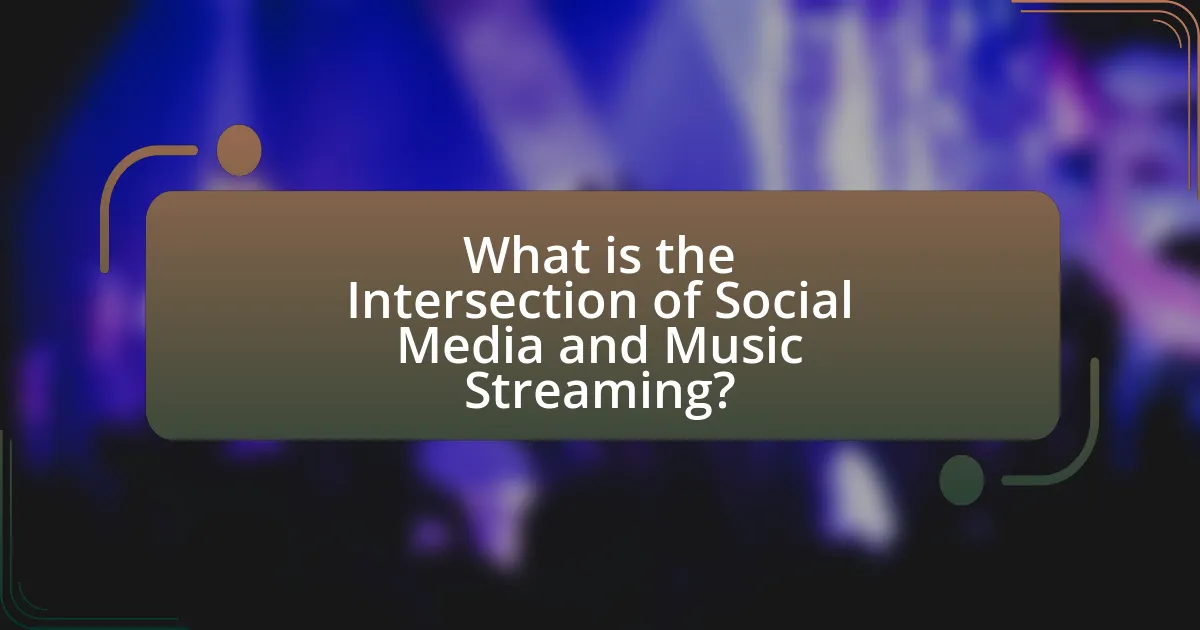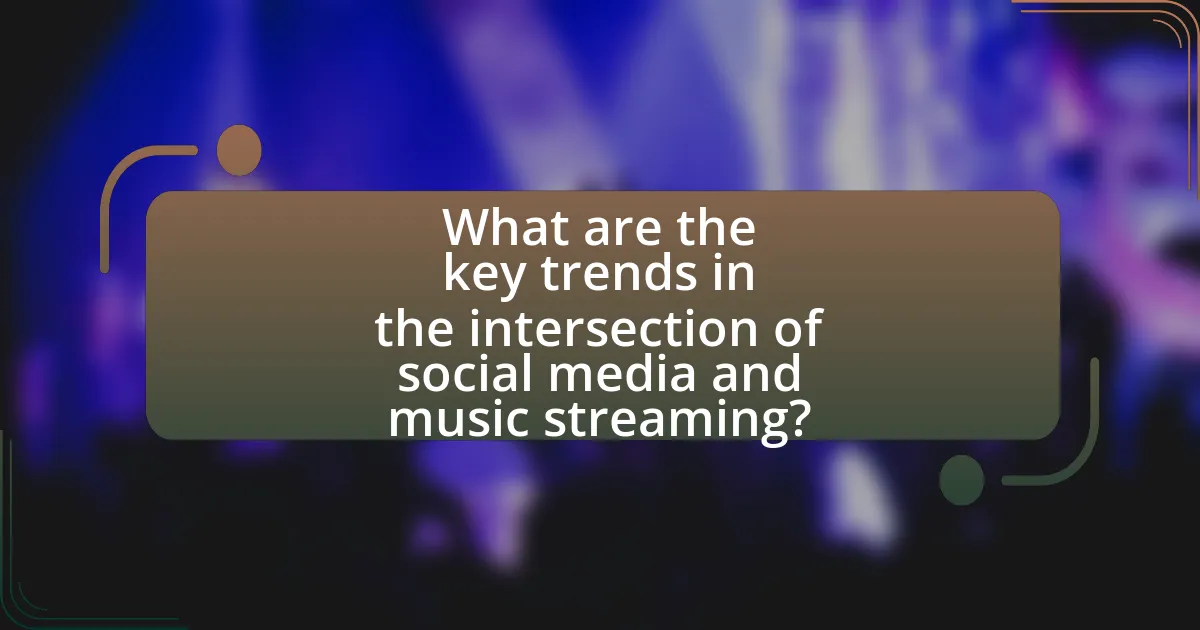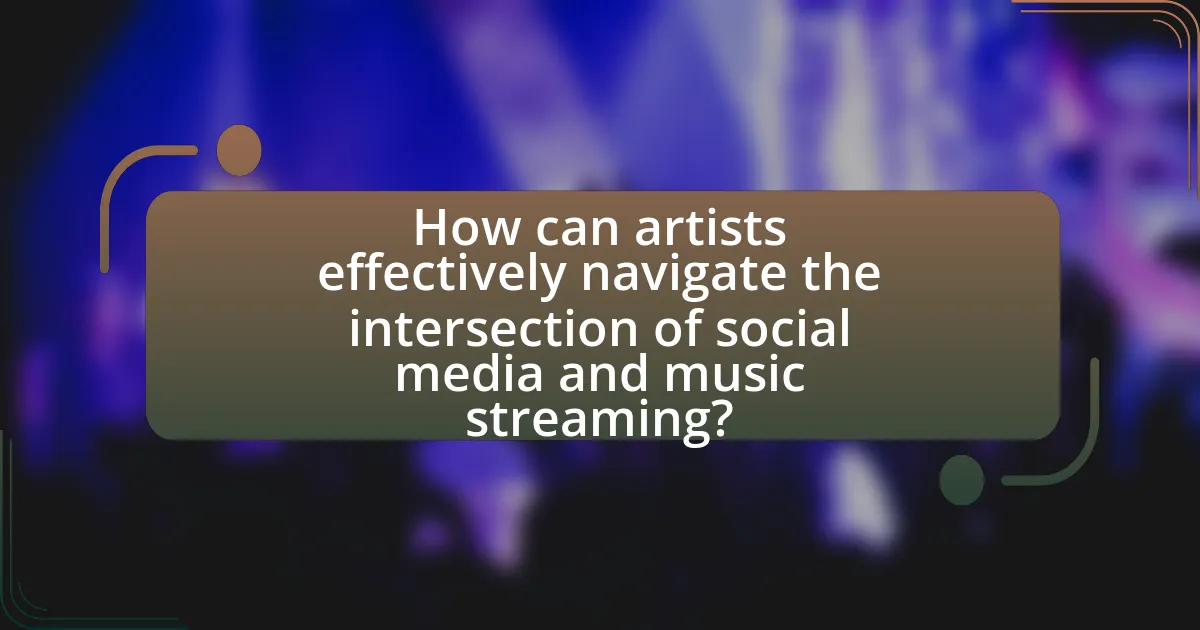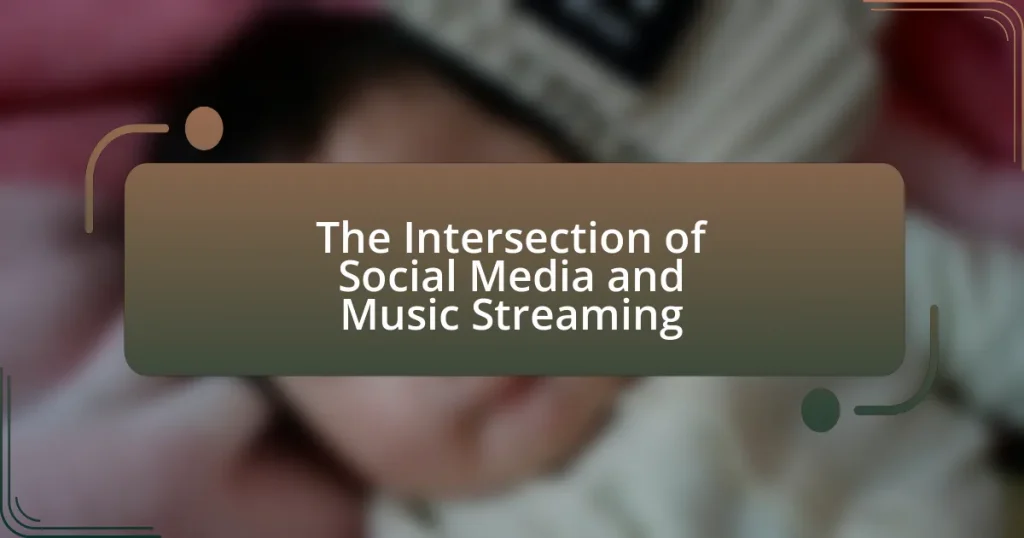The article examines the intersection of social media and music streaming, highlighting how platforms like TikTok and Instagram facilitate music discovery and artist promotion. It discusses the influence of user-generated content, algorithms, and audience engagement on streaming success, as well as the challenges artists face, including visibility and monetization issues. Key trends, strategies for effective engagement, and tools for analyzing social media impact on streaming are also explored, providing a comprehensive overview of how these two domains interact and shape the modern music landscape.

What is the Intersection of Social Media and Music Streaming?
The intersection of social media and music streaming is characterized by the integration of platforms that allow users to share, discover, and promote music. Social media platforms like Instagram, TikTok, and Twitter enable artists to engage directly with fans, while music streaming services such as Spotify and Apple Music provide the means for users to access and listen to music. This synergy enhances music promotion; for instance, TikTok has been pivotal in popularizing songs through viral challenges, leading to significant increases in streaming numbers. According to a report by the Recording Industry Association of America, music consumption in the U.S. has shifted dramatically, with streaming accounting for over 80% of the market, largely influenced by social media trends.
How do social media platforms influence music streaming services?
Social media platforms significantly influence music streaming services by driving user engagement and promoting music discovery. For instance, platforms like TikTok have led to viral trends that can propel songs to the top of streaming charts; the song “Old Town Road” by Lil Nas X gained immense popularity after being featured in TikTok videos, resulting in over 1.1 billion streams on Spotify. Additionally, social media allows artists to connect directly with fans, share new releases, and create buzz around their music, which can lead to increased streaming numbers. According to a report by Nielsen Music, 70% of music listeners discover new music through social media, highlighting its critical role in shaping listening habits and preferences.
What role do user-generated content and sharing play in music discovery?
User-generated content and sharing significantly enhance music discovery by facilitating organic engagement and personalized recommendations. Platforms like TikTok and Instagram allow users to create and share content featuring music, which often leads to viral trends and increased visibility for emerging artists. According to a 2021 report by the International Federation of the Phonographic Industry, 70% of music listeners discover new music through social media, highlighting the impact of user-generated content on audience reach. This sharing mechanism not only democratizes music promotion but also fosters community-driven exploration, making it easier for listeners to find diverse genres and artists that align with their tastes.
How do algorithms on social media affect music recommendations?
Algorithms on social media significantly influence music recommendations by analyzing user behavior, preferences, and interactions to curate personalized content. These algorithms track metrics such as likes, shares, and comments to identify trends and popular tracks among users, which in turn shapes the music that is recommended to individuals. For instance, platforms like Spotify and YouTube utilize collaborative filtering techniques, where user data is aggregated to suggest songs that similar users have enjoyed, thereby enhancing the likelihood of user engagement with new music. This method has been shown to increase user satisfaction and retention, as evidenced by Spotify’s report that personalized playlists like Discover Weekly have led to a 40% increase in user engagement.
Why is the relationship between social media and music streaming important?
The relationship between social media and music streaming is important because it significantly influences music discovery and audience engagement. Social media platforms serve as vital channels for artists to promote their music, connect with fans, and share content, which in turn drives traffic to music streaming services. For instance, a study by Nielsen found that 70% of music listeners discover new music through social media platforms, highlighting the critical role these platforms play in shaping listening habits. Additionally, the integration of music streaming services with social media allows for seamless sharing of playlists and songs, further enhancing user interaction and expanding an artist’s reach.
What impact does social media have on artist promotion and visibility?
Social media significantly enhances artist promotion and visibility by providing platforms for direct engagement with audiences. Artists can share their work, interact with fans, and build a personal brand, which increases their reach and visibility. For instance, a study by the Pew Research Center found that 72% of adults use social media, allowing artists to tap into a vast audience. Additionally, platforms like Instagram and TikTok have algorithms that promote content based on engagement, further amplifying an artist’s exposure. This direct access to fans and the ability to create viral content can lead to increased streaming numbers and concert attendance, demonstrating the critical role social media plays in modern artist promotion.
How does audience engagement on social media enhance streaming success?
Audience engagement on social media significantly enhances streaming success by increasing visibility and fostering community interaction. When artists actively engage with their audience through posts, comments, and live sessions, they create a sense of connection that encourages fans to share content, leading to greater reach. For instance, a study by Nielsen Music found that 70% of fans are more likely to stream music from artists they follow on social media, demonstrating a direct correlation between social media engagement and streaming activity. This engagement not only drives traffic to streaming platforms but also cultivates loyal fan bases that contribute to sustained streaming success.

What are the key trends in the intersection of social media and music streaming?
Key trends in the intersection of social media and music streaming include the rise of user-generated content, the integration of music discovery features within social platforms, and the use of social media for artist promotion and fan engagement. User-generated content, particularly on platforms like TikTok, has significantly influenced music trends, with viral challenges driving streaming numbers. Additionally, platforms such as Instagram and Facebook have incorporated music discovery tools, allowing users to share and discover songs seamlessly. Furthermore, artists increasingly leverage social media for direct interaction with fans, utilizing live streams and behind-the-scenes content to enhance engagement and build community. These trends reflect the evolving landscape where social media and music streaming are increasingly interconnected, shaping how music is consumed and promoted.
How are artists leveraging social media for music releases?
Artists are leveraging social media for music releases by utilizing platforms like Instagram, TikTok, and Twitter to engage directly with their audience, create buzz, and promote their new music. For instance, artists often share teasers, behind-the-scenes content, and countdowns to build anticipation before a release. According to a 2021 report by the International Federation of the Phonographic Industry, 70% of artists reported that social media significantly impacted their ability to reach fans and promote their music effectively. This direct interaction not only fosters a sense of community but also allows artists to gather immediate feedback and adapt their marketing strategies accordingly.
What strategies do musicians use to engage fans on social media?
Musicians engage fans on social media through strategies such as interactive content, live streaming, and personalized communication. Interactive content, including polls and Q&A sessions, encourages fan participation and fosters a sense of community. Live streaming performances or behind-the-scenes content allows musicians to connect with fans in real-time, enhancing the personal connection. Personalized communication, such as responding to comments and messages, builds loyalty and makes fans feel valued. According to a 2021 study by the International Federation of the Phonographic Industry, 70% of fans reported feeling more connected to artists who actively engage with them on social media platforms.
How do viral trends on social media platforms affect music charts?
Viral trends on social media platforms significantly impact music charts by driving increased streams and downloads of specific songs. When a song becomes associated with a viral challenge, meme, or trend, it often leads to a surge in its popularity, resulting in higher chart positions. For instance, the song “Old Town Road” by Lil Nas X gained immense popularity after going viral on TikTok, which contributed to its record-breaking run at number one on the Billboard Hot 100 for 19 weeks. This demonstrates how social media can amplify a song’s reach and influence its commercial success, as platforms facilitate rapid sharing and engagement among users.
What challenges do artists face at this intersection?
Artists face significant challenges at the intersection of social media and music streaming, primarily related to visibility and monetization. The oversaturation of content on platforms leads to difficulties in gaining attention, as millions of artists compete for listener engagement. Additionally, the revenue generated from streaming services is often insufficient, with artists typically receiving a fraction of a cent per stream, which complicates their financial sustainability. According to a 2021 report by the Music Industry Association, artists earn an average of $0.004 per stream, highlighting the economic strain they experience in this digital landscape. Furthermore, the algorithms used by social media platforms can favor certain types of content, making it challenging for diverse musical styles to reach broader audiences.
How do copyright issues arise from social media and music streaming interactions?
Copyright issues arise from social media and music streaming interactions primarily due to unauthorized use of copyrighted music in user-generated content. When users upload videos or posts featuring music without obtaining the necessary licenses, they infringe on the rights of copyright holders, which can lead to legal disputes. For instance, platforms like YouTube and TikTok have implemented Content ID systems to detect and manage copyrighted material, highlighting the prevalence of these issues. According to a 2021 report by the International Federation of the Phonographic Industry, 70% of music consumption occurs through streaming services, increasing the likelihood of copyright violations as users share content across social media.
What are the risks of overexposure on social media for musicians?
Overexposure on social media poses significant risks for musicians, including brand dilution, mental health issues, and potential backlash from audiences. When musicians frequently share content, they may overwhelm their audience, leading to decreased engagement and interest in their work. Research indicates that constant visibility can contribute to anxiety and depression, as musicians may feel pressured to maintain a perfect online persona. Additionally, overexposure can result in negative feedback or criticism, which can harm a musician’s reputation and career trajectory. For instance, a study published in the Journal of Music and Health highlights the correlation between social media stress and mental health challenges among artists, emphasizing the need for balanced online presence.

How can artists effectively navigate the intersection of social media and music streaming?
Artists can effectively navigate the intersection of social media and music streaming by leveraging social media platforms to promote their music, engage with fans, and build a personal brand. Utilizing platforms like Instagram, TikTok, and Twitter allows artists to share snippets of their music, behind-the-scenes content, and personal stories, which can drive traffic to their music on streaming services. For instance, TikTok has become a powerful tool for music discovery, with songs going viral and leading to significant increases in streaming numbers; a study by the University of Southern California found that songs featured in TikTok videos saw a 1,000% increase in streams. Additionally, artists should collaborate with influencers and other musicians on social media to expand their reach and tap into new audiences, as collaborations can lead to cross-promotion and increased visibility on both social media and streaming platforms.
What best practices should artists follow for maximizing their reach?
Artists should consistently engage with their audience across multiple social media platforms to maximize their reach. This engagement includes posting regular updates, responding to comments, and sharing behind-the-scenes content, which fosters a sense of community and connection. According to a study by the Pew Research Center, 72% of the public uses social media, making it a vital tool for artists to promote their work and connect with fans. Additionally, utilizing music streaming platforms effectively by releasing singles, collaborating with other artists, and leveraging playlists can significantly enhance visibility. Data from Spotify indicates that tracks featured on popular playlists can see a 10-fold increase in streams, demonstrating the importance of strategic placement in music distribution.
How can artists create engaging content that resonates with their audience?
Artists can create engaging content that resonates with their audience by understanding their audience’s preferences and utilizing storytelling techniques. Research indicates that content that tells a story can increase audience engagement by up to 300%, as it fosters emotional connections. By analyzing data from social media interactions and streaming platforms, artists can tailor their content to reflect the interests and values of their followers, ensuring relevance and relatability. Additionally, incorporating visual elements, such as videos and graphics, enhances engagement, as studies show that posts with visuals receive 94% more views than text-only posts.
What tools can artists use to analyze their social media impact on streaming?
Artists can use tools like Hootsuite, Sprout Social, and Google Analytics to analyze their social media impact on streaming. Hootsuite allows artists to track engagement metrics across various platforms, providing insights into how social media activity correlates with streaming numbers. Sprout Social offers detailed analytics on audience demographics and engagement, helping artists understand which posts drive streaming traffic. Google Analytics can be integrated with artists’ websites to monitor referral traffic from social media to streaming platforms, enabling a clear view of how social media efforts translate into streaming performance. These tools collectively provide data-driven insights that help artists optimize their social media strategies for better streaming outcomes.
What common pitfalls should artists avoid in this space?
Artists should avoid the pitfall of neglecting audience engagement on social media platforms. Engaging with fans fosters loyalty and increases visibility, which is crucial in the competitive landscape of music streaming. According to a study by the Berklee College of Music, artists who actively interact with their audience on social media see a 30% increase in streaming numbers compared to those who do not engage. Additionally, artists should refrain from over-promoting their music without providing value, as this can lead to audience fatigue and disengagement. Balancing promotional content with authentic interactions is essential for maintaining a healthy relationship with fans.
How can artists prevent burnout from constant social media engagement?
Artists can prevent burnout from constant social media engagement by setting clear boundaries around their online presence. Establishing specific times for social media use allows artists to engage meaningfully without feeling overwhelmed. Research indicates that taking regular breaks from social media can significantly reduce stress and anxiety levels, which are common contributors to burnout. For instance, a study published in the Journal of Social and Clinical Psychology found that limiting social media use to 30 minutes a day led to improved well-being among participants. By prioritizing mental health and creating a balanced approach to social media, artists can maintain their creativity and passion for their work.
What mistakes do artists make when promoting their music on social media?
Artists often make the mistake of not engaging with their audience when promoting their music on social media. This lack of interaction can lead to diminished fan loyalty and reduced visibility. For instance, a study by the Pew Research Center found that 70% of social media users expect brands and public figures to respond to their comments, indicating that engagement is crucial for building a community. Additionally, artists frequently post promotional content without providing value or entertainment, which can result in followers losing interest. According to a report by Hootsuite, posts that include engaging content receive 94% more views than those that are purely promotional. Therefore, failing to engage and provide valuable content are significant mistakes artists make in their social media promotion efforts.
